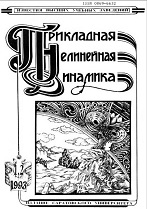|
This article is cited in 1 scientific paper (total in 1 paper)
APPLIED PROBLEMS OF NONLINEAR OSCILLATION AND WAVE THEORY
Frequency repulsion in ensembles of general limit-cycle oscillators synchronized by common noise in the presence of global desynchronizing coupling
D. S. Goldobinab, A. V. Dolmatovaa
a Institute of Continuous Media Mechanics UB RAS, Perm
b Perm State National Research University
Abstract:
Topic. We study the interaction of two fundamentally different synchronization mechanisms: by means of coupling and by means of the driving by a random signal, which is identical for all oscillators – common noise. Special attention is focused on the effect of frequency divergence arising from the competition between these mechanisms. Aim. The aim of the paper is to construct a universal theory describing such an interaction for a general class of smooth limit-cycle oscillators with a global coupling. The effect of intrinsic noise, which is individual for each oscillator, is also to be taken into account. We also plan to assess how the results obtained earlier for the systems of the Ott–Antonsen type reflect the situation in general case. Method. For a general class of oscillators, the phase description is introduced. For the Fokker–Planck equation, which corresponds to the stochastic equations of phase dynamics, a rigorous averaging procedure is performed in the limit of high oscillation frequency (the conventional multiple scale method is used). With the derived equations one can obtain the conditions for synchronization of ensembles of identical oscillators, and for weakly nonidentical oscillators, one can find the average oscillation frequencies in quadratures. Analytical results are verified by direct numerical simulations for large but finite ensembles of van der Pol, Rayleigh and van der Pol–Duffing oscillators, as well as for FitzHugh-Nagumo neuronlike oscillators. Results. For the case of identical oscillators without intrinsic noise, a sufficiently strong common noise synchronizes an ensemble with a repulsive global coupling, and the dynamics of localization of the oscillator distribution is investigated. The latter clearly indicates that during the transition to the state of perfect synchrony, the distribution of oscillators possesses «heavy» power-law tails, even with an arbitrary strong attracting global coupling – without common noise, such tails do not apper. For the case of oscillators with intrinsic noise, the equilibrium distribution of phase differences always possesses «heavy» power-law tails, and the parameters of these tails are determined. The asymptotic behavior for the average frequency of an oscillator as a function of the natural frequency is derived analytically; in particular, the effect of divergence of the average frequencies is reported to accompany the synchronization by common noise in the presence of a repulsive global coupling. Examples of the application of the constructed theory for van der Pol, Rayleigh, van der Pol–Duffing and FitzHugh–Nagumo oscillators are presented. The results of direct numerical simulation for large finite ensembles of these oscillators are consistent with the theory. Discussion. Arbitrary weak general noise, on the one hand, increases the stability of the synchronous state, and on the other hand, it always creates «heavy» power-law tails for the distribution of phase differences. This indicates a significantly intermittent character of synchronization by common noise-epoches of synchronous behavior are interrupted by the phase difference slips – and is consistent with the fact that in the presence of common noise, a perfect frequency locking becomes impossible. For a repulsive coupling, a nontrivial effect occurs: sufficiently strong common noise synchronizes the states of oscillators, but their average frequencies are mutually repelled. The effect of individual intrinsic noise on the average frequencies is effectively equivalent to the effect of synchrony imperfection.
Keywords:
Synchronization, stochastic processes, frequency repulsion, synchronization by common noise.
Received: 12.03.2019
Citation:
D. S. Goldobin, A. V. Dolmatova, “Frequency repulsion in ensembles of general limit-cycle oscillators synchronized by common noise in the presence of global desynchronizing coupling”, Izvestiya VUZ. Applied Nonlinear Dynamics, 27:3 (2019), 33–60
Linking options:
https://www.mathnet.ru/eng/ivp107 https://www.mathnet.ru/eng/ivp/v27/i3/p33
|

|




 Contact us:
Contact us: Terms of Use
Terms of Use
 Registration to the website
Registration to the website Logotypes
Logotypes








 Citation in format
Citation in format 
